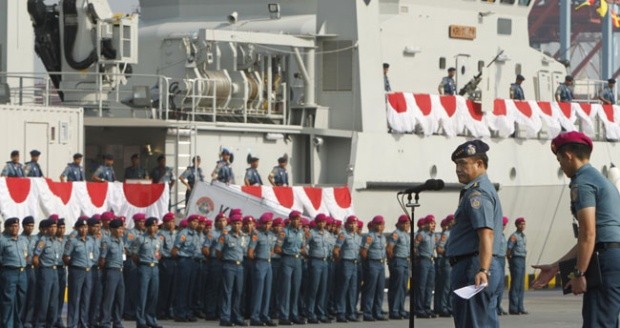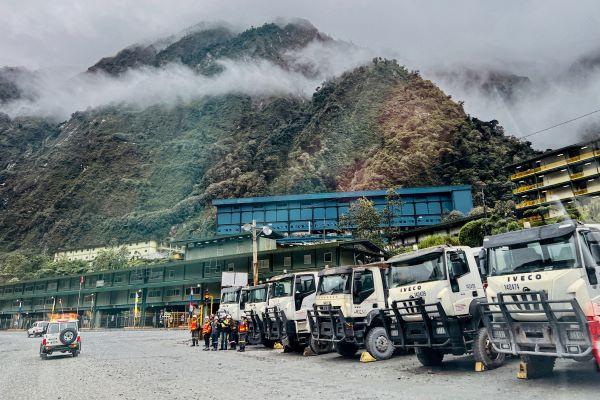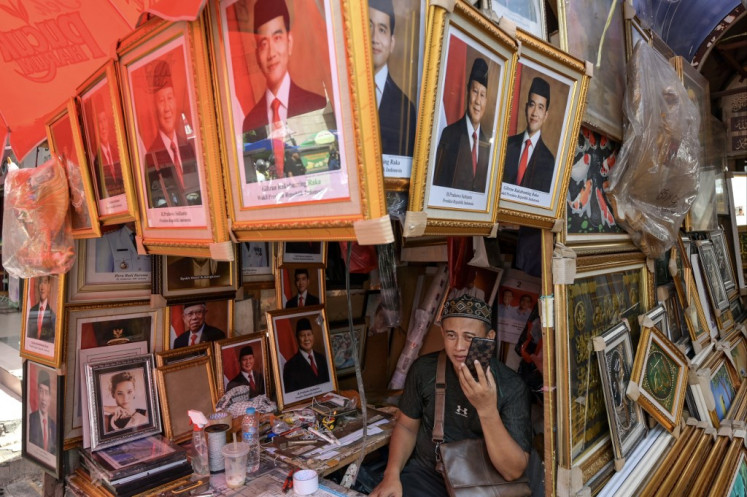Uphill battle for Indonesia's defense modernization
Though Jokowi does have a grand maritime vision for the country, there are a lot of challenges ahead before Indonesia can become a global maritime fulcrum in Southeast Asia.
Change Size
 Indonesian Navy chief of staff Adm. Ade Supandi leads the handover ceremony of the KRI Rigel-933 and KRI Spica-934 at Kolinlamil harbor, Jakarta, on March 15. (Tempo/Subekti)
Indonesian Navy chief of staff Adm. Ade Supandi leads the handover ceremony of the KRI Rigel-933 and KRI Spica-934 at Kolinlamil harbor, Jakarta, on March 15. (Tempo/Subekti)
T
he more expert analyses I read on the issue of naval and defense modernization in Indonesia, the more I realize that there are many challenges ahead. Though Jokowi does have a grand maritime vision for the country, there are a lot of challenges ahead before Indonesia can become a global maritime fulcrum in Southeast Asia.
The first challenge is devising a sound defense strategy. Currently, the public document that can be relied on to connect the dots of the scattered defense documents Indonesia has is the Defense White Paper.
(Read also: The superficiality of Indonesia's defense policy)
The overall defense strategy has yet to evolve to meet the needs of Indonesia’s defense and the changing strategic environment. The 2015 Defense White Paper continues to emphasize the “total defense” doctrine and provides an insufficient explanation about the workings of Jokowi’s global maritime fulcrum (GMF) vision. In the maritime realm, an area that has supposedly gained significant interest since the start of Jokowi’s campaign, the White Paper glosses over the issue, saying only that maritime security should be enhanced using radars and drones. Instead of the GMF, the White Paper dedicates itself to the elaboration of the bela negara program. However, the White Paper does not offer a plausible explanation on how that program might support the GMF.
The White Paper also suffers from a poor threat assessment method. The classification of threats into “factual” and “non-factual” ones is confusing. At first glance, the term “non-factual” implies that a threat is fictional. What is more appalling is the classification of an armed aggression as a “non-factual” threat. This is a strategic error considering the increasing volatility of Southeast Asia, which is primarily due to the South China Sea dispute and China’s increased assertiveness in the disputed waters. Moreover, other Southeast Asian countries are increasing their military expenditure. Stockholm International Peace Research Institute (SIPRI) data show that defense spending in Asia in real terms has increased from US$38.7 billion in 2014 to $ 42.2 billion in 2015. Looking at the bigger picture of the decade, there has been a gradual increase in regional defense expenditure since 2005, when it stood at $25.8 billion. Although it would be erroneous to imply that increased defense expenditure contributes directly to insecurity in the region, it should be taken as a sign that an arms build-up is underway in Southeast Asia. There is a threat of external aggression that should not be considered a “non-factual” threat.
The second challenge would be naval and aerial modernization in order to construct the foundations of the GMF. The core of the GMF is a strong naval and aerial presence that can serve as the first line of defense in case of external aggression. To achieve that, it is inevitable to first increase the defense budget and subsequently procure defense equipment to modernize the Navy and Air Force. These proposals have their own subset of challenges.
Increasing the defense budget would prove to be difficult, especially given the recent across-the-board budget cuts. The 2015 defense budget was $8.071 billion, or 0.9 percent of the gross domestic product (GDP). For comparison, Singapore’s defense budget in the same year was $10.21 billion, or 3.2 percent of GDP. The defense budget is expected to be slashed by Rp 2.8 trillion. Furthermore, the 2015 Defense White Paper also specified that an increase in defense expenditure is unlikely, as the government would keep defense expenditure at around 1 percent of GDP. In an ideal scenario, the defense budget share would be around 3 percent of GDP to facilitate a smooth modernization process. That being said, an increase in the defense budget does not automatically translate into better equipment. A large chunk of the defense budget actually goes to providing for the welfare of the military, while only a small portion is spent on equipment procurement.
We arrive at a juncture, then. Which one should be prioritized? Ideally, we would like both our soldiers to be well fed and content, but at the same time, we need to catch up with the rest of the world in modernizing our defense equipment. However, if circumstances remain as they are, we cannot have both at the same time. The trade-off between soldiers’ welfare and equipment procurement is a tricky one to navigate around.
The third challenge would be the revitalization of defense industries to further increase Indonesia’s self-reliance. Recent events have shown that the government is keen to nurture Indonesia’s native defense industries. Jane’s Defence Weekly (Vol. 53, 48) reports that PT Pindad received a boost in state funding, which will hopefully translate into increased productivity and growth. In 2012, PT PAL received a capital injection of Rp 648 billion to modernize, further increasing its readiness for manufacturing the naval and undersea vessels that the GMF desperately needs.
(Read also: Achieving mastery of the seas)
However, the challenges of developing and maintaining a native defense industry still remain. For a defense industry to remain relevant, it should be innovative. To that end, a robust research and development component should be considered. This would require further funding and collaboration with engineering universities across Indonesia, along with defense cooperation with other advanced industries across the world. Again, a large amount of investment is required.
The fourth (but not last) challenge would be inter-service friction. For years now, the Navy and Air Force have been kept at the periphery. The spotlight has been on the Army for as long as anyone can remember. The Army’s way of thinking is deeply ingrained in formulating strategies, as evidenced in previous defense strategies outlined in the Defense White Papers and the overall Wawasan Nusantara outlook. Unfortunately, as circumstances change, the conventional territorial defense concept has become obsolete. It is time for a new defense strategy that favors the maritime realm, as potential threats will come from the sea.
The current defense modernization efforts may be considered a small step in what could be a large leap in Indonesian defense, and ultimately, in Indonesia’s political standing in the region. However, the battle is an uphill one, and to keep the ball rolling is a monumental task for not just the incumbent leader, but also for us as a nation.
***
The writer is a postgraduate student at the S. Rajaratnam School of International Studies (RSIS), Singapore, majoring in strategic studies. He is an alumnus of President University. His research interests are Indonesia’s defense and security policy, maritime security, civil-military relations, and future warfare. He can be reached on Linkedin, by email or at his blog, Scribbles from the Ivory Tower.
---------------
We are looking for information, opinions, and in-depth analysis from experts or scholars in a variety of fields. We choose articles based on facts or opinions about general news, as well as quality analysis and commentary about Indonesia or international events. Send your piece to community@jakpost.com. Click here for more information.









